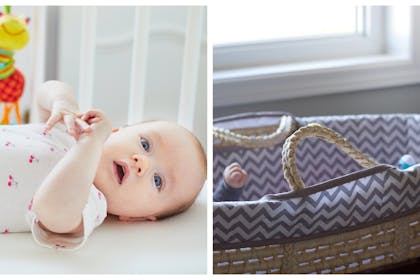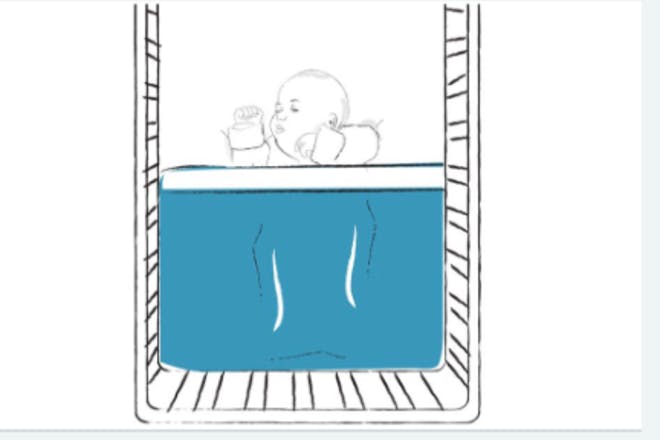Safe sleeping for babies: how to reduce the risk of SIDS

The Lullaby Trust, the UK's leading Sudden Infant Death Syndrome (SIDS) charity, has issued new safety guidelines for co-sleeping after a survey revealed that 40% of parents are doing it under dangerous circumstances. Here's what you need to know.
This page contains affiliate links, which means we may earn a small amount of money if a reader clicks through and makes a purchase. All our articles and reviews are written independently by the Netmums editorial team.
For years, The Lullaby Trust, a charity which gives support to families affected by SIDS and carries out research into the causes of cot death, has warned parents not to co-sleep with their babies after claiming it increases cot deaths.
However, the UK charity has now teamed up with Public Health England (PHE) to advise parents who do co-sleep about how to do it as safely as possible.
It comes after The Lullaby Trust surveyed 8,500 parents about their sleeping habits to mark Safer Sleep Week, which runs from 11 March – 17 March.
FREE NEWBORN NAPPIES
The results found that 76% of parents admitted to co-sleeping with their baby at some point and that 40% have done so under dangerous circumstances.
This includes falling asleep on an armchair or a sofa, which can increase the risk of SIDS by up to 50 times.
Meanwhile, 12% of mums and dads who replied are smokers who admitted to having shared a bed with their baby.
And 9% have done so after drinking alcohol.

The survey also found that 33% of parents had shared a bed with their baby in an unplanned situation.
According to The Lullaby Trust, 133 babies die each year in co-sleeping situations, many of which will be in high-risk circumstances.
Is co-sleeping safe?
Although The Lullaby Trust has always advised against co-sleeping, it recognises that parents do it.
And, whether it's planned or unplanned (by accidentally dozing off) it recognises the need to inform parents about the safety aspects, including how to prepare for unplanned co-sleeping.
Jenny Ward, Acting CEO of The Lullaby Trust has stressed the importance of acknowledging that co-sleeping happens and says that informing parents could help save lives.
She says:
'Co-sleeping needs to be discussed with all families. We know from talking to parents that if they are told not to co-sleep they will then feel they cannot discuss what actually happens. As a result they will not get important advice on how to co-sleep more safely.
'It is a reality that even if parents do not plan to co-sleep, many still fall asleep with their babies unintentionally. Babies can and do die in high risk co-sleeping situations.
'If given the right advice, parents can prepare for planned and unplanned co-sleeping that will help to mitigate those risks and reduce the chance of SIDS.'
Co-sleeping: how to do it safely
The Lullaby Trust has teamed up with Public Health England (PHE), Unicef UK Baby Friendly and Basis to give some key advice for safer co-sleeping.
If you are going to do it, follow this advice:
- Keep the space around your baby clear of pillows and duvets.
- Always sleep your baby on their back.
- Avoid letting pets or other children in the bed.
- Make sure your baby cannot fall out of bed or become trapped between the mattress and wall.
- Never leave baby alone in the bed.
How NOT to do co-sleeping
According to latest advice, you should NEVER sleep with your baby on a sofa or armchair, this increases the risk of SIDS by 50 times.
It is important to know there are some circumstances where it is dangerous to share a bed with your baby.
You should not co-sleep if:
- Either you or anyone in the bed smokes (even if you do not smoke in the bedroom).
- Either you or anyone in the bed has recently drunk any alcohol.
- You or anyone in the bed has taken any drugs that make you feel sleepy.
- Your baby was born prematurely (before 37 weeks of pregnancy)or weighed under 2.5kg when they were born.
What is Sudden Infant Death Syndrome (SIDS)?
Tragically, around 250 babies die from Sudden Infant Death Syndrome – also known as SIDS or cot death – every year. Although the exact causes of SIDS is still unclear, there are ways you can create a safer sleeping environment for your baby.
While the reasons some babies die of SIDS is still unknown, the 'Back to Sleep' campaign – a campaign launched in 1991 advising parents to put their babies to sleep on their backs – has helped enormously.
In fact, it has helped to reduce the rates of cot death by as much as 85%.
Your baby needs a lot of sleep – around 14-17 hours a day for newborns – so making sure he's sleeping safely is hugely important.
Keep reading to find out the latest advice for putting your baby down to sleep as safely as possible ...
How should I put my baby down to sleep safely?
As experts on this topic, The Lullaby Trust gives the following advice on how to create a safer sleeping environment for your baby:
- Always put your baby to sleep on his back
There is a huge amount of evidence that shows putting your baby to sleep on his back at the beginning of every sleep or nap significantly reduces his risk of sudden infant death.
Make sure you always put him in this position, unless your doctor has advised you otherwise.
Putting a baby to sleep on their front or side greatly increases the chance of SIDS.
If your baby rolls over after you've put him down in his Moses basket or cot, roll him onto his back again.
However, when your baby is able to roll from back to front and back again on his own, he can be left to find his own sleeping position.
- Put your baby in his own Moses basket, crib or cot
The safest place for your baby to sleep is in a separate cot or Moses basket in the same room as you for the first six months. This includes for both daytime naps and nighttime sleep.
The chance of SIDS occurring is lower when your baby sleeps in a separate cot in the same room as you.
- Don't fall asleep with your baby on the sofa
As mentioned above, never sleep with your baby on a chair or sofa, even in the day. This can increase the risk of SIDS occurring by 50 times.
- Use a firm mattress
Invest in a firm, flat mattress for your baby to sleep on. Make sure it's clean and in good condition. Using a waterproof mattress cover will help you keep it clean and dry.
- Don't give your baby pillows or loose bedding
Things like loose bedding, pillows, cot bumpers and soft toys, which can cover your baby’s face or head can be dangerous and can increase the chance of SIDS.
Make up your baby's bedding at the foot of the cot and put your baby in the 'feet to foot' position – meaning his feet are at the foot of the cot or Moses basket – so he can't wriggle down under the covers.
Any blankets should be firmly tucked in, no higher than your baby's shoulders. Alternatively, use a baby sleeping bag.
- Make sure your baby doesn't get too hot
The temperature in the room your baby is sleeping in should be around 16-20 degrees – invest in a room thermometer so you can monitor the temperature.
Also make sure your baby's cot is not next to a radiator or heater (a room thermometer is the best way to keep track of this).
However, remember that all babies are different, so make sure you check your baby regularly to check he's not too hot. You can do this by checking he's not sweating. You can also feel his tummy - this is a good indication of how hot he is as his hands and feet will usually be cooler.
If your think your baby is too hot, take away a layer of bedclothes. And be aware that if your baby is poorly, he'll need fewer bedclothes, not more.
- Consider giving your baby a dummy
Some research suggests that giving your baby a dummy when putting him down to sleep might reduce the risk of sudden infant death – although it's not clear why.
If you are breastfeeding, wait until breastfeeding is well established (at up to about 4 weeks old). Also never use a neck cord with your baby's dummy.
- Don't smoke near your baby, or anywhere in the house
Smoking during pregnancy and after your baby is born increases the chance of SIDS.
If you or your partner smoke, you're advised not to share a bed with your baby as again, this greatly increases the chance of SIDS. This is the case even if you don't smoke in your bedroom, or at home.
- Breastfeed your baby
It's believed that babies who are breastfed have a lower risk of SIDS.
Need advice?
Our health visitors and nursery nurses are on line Monday to Friday evenings to answer your queries on feeding, sleep and child health.
How to do the 'feet to foot' position
Health experts agree that putting your baby in the cot 'feet to foot' helps avoid them wriggling down the cot and getting tangled in their covers.
Here's how the NHS recommends putting your baby in the 'feet to foot' position:
- Tuck the covers in securely under your baby's arms so they can't slip over their head. Use 1 or more layers of lightweight blankets.
- Use a baby mattress that's firm, flat, well-fitting, clean and waterproof on the outside. Cover the mattress with a single sheet.
- Don't use duvets, quilts, baby nests, wedges, bedding rolls or pillows.
Here's what it should look like ...

Where can I find out more about safe sleeping and SIDS support?
For more information about The Lullaby Trust, visit their website or call the information line on 0808 802 6869.
Any parents who have been affected by SIDS can contact the bereavement support line on 0808 802 6868.
Related articles
Sleep nests and pods increase the risk of SIDS, charity says


